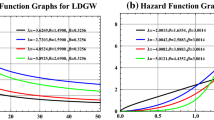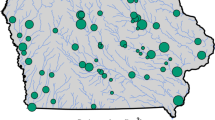Abstract
This paper empirically investigates the asymptotic behaviour of the flood probability distribution and more precisely the possible occurrence of heavy tail distributions, generally predicted by multiplicative cascades. Since heavy tails considerably increase the frequency of extremes, they have many practical and societal consequences. A French database of 173 daily discharge time series is analyzed. These series correspond to various climatic and hydrological conditions, drainage areas ranging from 10 to 105 km2, and are from 22 to 95 years long. The peaks-over-threshold method has been used with a set of semi-parametric estimators (Hill and Generalized Hill estimators), and parametric estimators (maximum likelihood and L-moments). We discuss the respective interest of the estimators and compare their respective estimates of the shape parameter of the probability distribution of the peaks. We emphasize the influence of the selected number of the highest observations that are used in the estimation procedure and in this respect the particular interest of the semi-parametric estimators. Nevertheless, the various estimators agree on the prevalence of heavy tails and we point out some links between their presence and hydrological and climatic conditions.












Similar content being viewed by others
References
Anderson PL, Meerschaert M (1998) Modeling river flows with heavy tails. Water Resour Res 34(9):2271–2280
Bak P (1997) How nature works: the science of self-organized criticality. Oxford University Press Oxford
Beirlant J, Teugels JL, Vynckiee P (1996) Practical analysis of extreme values. Leuven University Press Leuven
Bendjoudi H et al (2004) Prédétermination multifractales des précipitations et des crues. Rapport final projet RIO2, MEDD, Paris
Barnett V (1975) Probability plotting methods and order statistics. Appl Stat 24:95–108
Chambers JM (1977) Computational methods for data analysis. Wiley, New York
Coles S (2001) An introduction to statistical modeling of extreme values. London
Csorgo M, Deheuvels P, Mason D (1985) Kernel estimate of the tail index of a distribution. Ann Stat 13:1050–1077
Cunnane C (1973) A particular comparison of annual maxima and partial duration series methods of flood frequency prediction. J Hydrol 18:257–271
Cunnane C (1988) Methods and merits of regional flood frequency analysis. J Hydrol 100:269–290
De Haan L (1970) On regular variation and its applications to weak convergence of sample extremes, vol.32 de CWI Tract. Amsterdam
De Michele C, Salvadori G (2005) Some hydrological applications of small sample estimators of Generalized Pareto and extreme value distributions. J Hydrol 301(1–4):37–53
Douglas E, Barros AP (2003) Probable maximum precipitation estimation using multifractals: application in the Eastern United States. J Hydrometeorol 4(6):1012–1024
Fisher R, Tippett L (1928) On the estimation of the frequency distributions of the largest or smallest member of a sample. Proceedings of the Cambridge Philosophical Society 24:180–190
Gnedenko B (1943) Sur la distribution limite du terme maximum d’une série aléatoire. Ann Math 44:423–453
Greenwood JA, Landwher JM, Matalas NC, Wallis JR (1979) Probability weighted moments: definition and relation to parameters of several distributions expressible in inverse form. Water Resour Res 15(5):1049–1054
Gupta VK, Waymire E (1990) Multiscaling properties of spatial rainfall and river flow distributions. J Geophys Res 95(D3):1999–2009
Hall P (1982) On some simple estimate of an exponent of regular variation. J R Stat Soc 44:37–42
Hill BM (1975) A simple general approach to inference about the tail of a distribution. Ann Stat 3(5):1163–1174
Hosking JRM (1990) L-moments: analysis and estimation of distributions using linear combinations of order statistics. J R Stat Soc Ser B (Methodological) 52(1):102–124
Hosking JRM, Wallis JR (1987) Parameter and quantile estimation for Generalized Pareto distribution. Technometrics 29(3):339–349
Hubert P, Tessier Y, Lovejoy S, Schertzer D, Schmitt F, Ladoy P, Carbonnel JP, Violette S, Desurosne I (1993) Multifractals and extreme rainfall events. Geophys Res Lett 20:931–934
Hubert P, Tchiguirinskaia I, Bendjoudi H, Schertzer D, Lovejoy S (2002) Multifractal modeling of the Blavet River discharges at Guerledan, Third celtic hydrology colloquium, Galway, Ireland
Hubert P, Tchiguirinskaia I, Bendjoudi H, Schertzer D, Lovejoy S (2005) Multifractal modeling of flood. In: Jiri M, Gheorghe S, Gabor B (eds) Transboundary floods: reducing risks through flood management proceedings of the NATO advanced research workshop on transboundary floods: reducing risks and enhancing security through improved flood management planning, Baile Felix (Oradea), Romania, 4–8 May 2005 Series: Nato Science Series: IV: Earth and Environmental Sciences, vol 72 2006, X, 336 p., Softcover ISBN-10: 1-4020-4901-3 ISBN-13: 978-1-4020-4901-9
Hurst HE (1951) Long-term storage capacity of reservoir. Trans Am Soc Civ Eng 116:770
Javelle P, Ouarda TBMJ, Lang M, Bobée B, Galéa G, Grésillon JM (2002) Development of regional flood-duration-frequency curves based on the index-flood method. J Hydrol 258:249–259
Jenkinson AF (1955) The frequency distribution of the annual maximum (or minimum) value of meteorological elements. Q J R Meteorol Soc 81:158–171
Kottegoda NT, Rosso R (1997) Statistics, probability and reliability for civil and environmental engineers. McGraw-Hill New York
Labat D, Mangin A, Ababou R (2002) Rainfall-runoff relations for karstic springs: multifractal analyses. J Hydrol 256(3–4):176–195
Lang M, Ouarda TBMJ, Bobée B (1999) Towards operational guidelines for over-threshold modeling. J Hydrol 225(3–4):103–117
Lovejoy S, Schertzer D (1990) Multifractals, universality classes, satellite and radar measurement of clouds and rain. J Geophys Resour 95:2021–2034
Lovejoy S, Schertzer D (1995) Multifractals and rain. In: Kunzewicz ZW (ed) New uncertainity concepts in hydrology and water resources. Cambridge University Press, Cambridge, pp 62–103
Madsen H, Rosbjerg D (1997) The partial duration series method in regional index-flood modeling. Water Resour Res 33(4):737–746
Majone B, Bellin A, Borsato A (2004) Runoff generation in karst catchments: multifractal analysis. J Hydrol 294(1–3):176–195
Malamud BD, Turcotte DL (2006) The applicability of power-law frequency statistics to floods. J Hydrol Hydrofractals ‘03’ 322(1–4):168–180
Mandelbrot BB, Wallis JR (1968) Noah, Joseph, and operational hydrology. Water Resour Res 4(5):909–918
Merz R, Bloschl G (2005) Flood frequency regionalisation–spatial proximity versus catchment attributes. J Hydrol 302(1–4):283–306
Moon YI, Lall U, Bosworth K (1993) A comparison of tail probability estimators for flood frequency analysis. J Hydrol 151(2–4):343–363
Naulet R, Lang M, Coeur D, Gigon C (2001) Collaboration between historians and hydrologists on the Ardèche River (France). First step: inventory of historical flood information. In: Paola Albini TG, Felix France (eds) Advances in natural and technological research: the use of historical data in natural hazard assessment. Kluwer, Dordrecht, pp 113–129
Naulet R et al (2005) Flood frequency analysis on the Ardèche river using French documentary sources from the last two centuries. J Hydrol Palaeofloods, historical data and climate variability: applications in flood risk assessment 313(1–2):58–78
Pandey G, Lovejoy S, Schertzer D (1998) Multifractal analysis of daily river flows including extremes for basins of five to two million square kilometres, one day to 75 years. J Hydrol 208(1–2):62–81
Pandey MD, Van Gelder PHAJM, Vrijling JK (2001) The estimation of extreme quantiles of wind velocity using L-moments in the peaks-over-threshold approach. Struct Saf 23(2):179–192
Payrastre O, Gaume E, Andrieu H (2005) Use of historical data to assess the occurrence of floods in small watershed in the French Mediterranean area. Adv Geosci 2:313–320
Pickands J (1975) Statistical inference using extreme order statistics. Ann Stat 3(1):119–131
Renard B (2006) Détection et prise en compte d’éventuels impacts du changement climatique sur les extrêmes hydrologiques en France. Thèse INP Grenoble, Cemagref Lyon, 20 September, p 361
Rodriguez-Iturbe I, Rinaldo A (1997) Fractal River basin, chance and self-organization. Cambridge University Press, New York
Schertzer D, Lovejoy S (1987) Physical modeling and analysis of rain and clouds by anisotropic scaling of multiplicative processes. J Geophys Res D8(8):9693–9714
Schertzer D, Lovejoy S (1991) Non-linear variability in geophysics, scaling and fractals, Kluwer, Dordrecht-Boston, pp 318
Schertzer D, Lovejoy S (1992) Hard and soft multifractal processes. Physica A 185:187–194
Schertzer D, Lovejoy S, Hubert P (2002) An introduction to stochastic multifractal fields. In: Ern A, Liu W (eds) ISFMA symposium on environmental science and engineering with related mathematical problems. High Education Press, Beijing, pp 106–179
Stedinger JR, Cohn TA (1986) Flood frequency analysis with historical and paleoflood information. Water Resour Res 22(5):785–793
Tchiguirinskaia I, Schertzer D, Hubert P, Bendjoudi H, Lovejoy S (2004) Multiscaling geophysics and sustainable development. In: Tchiguirinskaia I, Hubert P (eds) Scales in hydrology and water management. IAHS, Paris, pp 113–136
Tessier Y, Lovejoy S, Hubert P, Schertzer D, Pecknold S (1996) Multifractal analysis and modeling of rainfall and river flows and scaling, causal transfer functions. J Geophys Res Atmos 101(D21):26427–26440
Turcotte DL, Greene A (1993) Scale-invariant approach to flood frequency analysis. Stochastic Hydrology and Hydraulics 7:33–40
Wang QJ (1997) Using higher probability weighted moments for flood frequency analysis. J Hydrol 194(1–4):95–106
Willems P (1998) Hydrological applications of extreme value analysis. In: Wheater H, Kirby C (eds) Hydrology in a changing environment. Wiley, Chichester, pp 15–25
Willems P (2000) Compound intensity/duration/frequency-relationships of extreme precipitation for two seasons and two storm types. J Hydrol 233(1–4):189–205
Acknowledgments
The authors gratefully acknowledge the French Ministry of Ecology and Sustainable Development for providing data. The paper has been improved by helpful comments from the two anonymous reviewers.
Author information
Authors and Affiliations
Corresponding author
Rights and permissions
About this article
Cite this article
Bernardara, P., Schertzer, D., Sauquet, E. et al. The flood probability distribution tail: how heavy is it?. Stoch Environ Res Risk Assess 22, 107–122 (2008). https://doi.org/10.1007/s00477-006-0101-2
Published:
Issue Date:
DOI: https://doi.org/10.1007/s00477-006-0101-2




